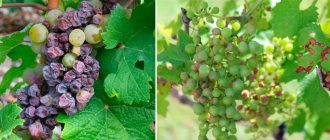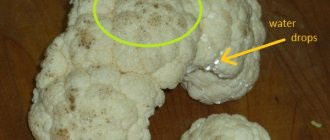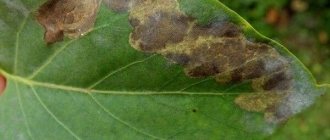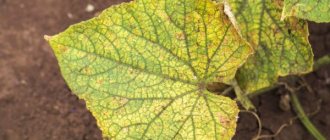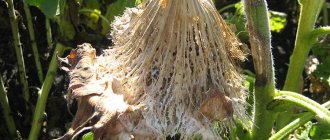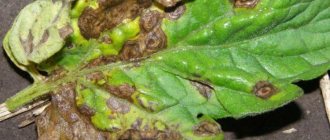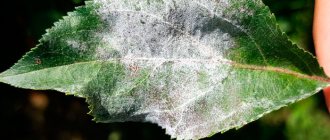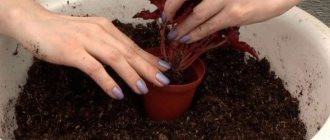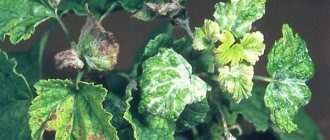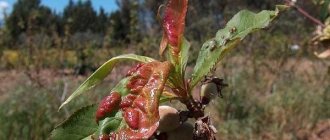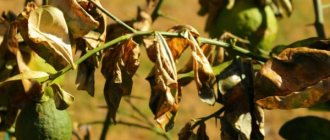Common diseases and treatments
Such a useful shrub as barberry, crowned with red berries, often succumbs to various fungal and even cancer diseases. Diseases significantly deplete the crop, thereby negatively affecting the quality of the crop itself, reducing its quantity.
Cancers
When a healthy plant, for certain reasons, has reduced immunity, it can be affected by cancer cells. Peculiar growths begin to form on barberry branches. The bark cracks, some areas rot, and the yield is significantly reduced.
To help the bush, you need to trim its diseased areas and then clean them. To do this, the sections are smeared with vitriol, and the entire bush is treated with Fundazol.
Bacteriosis
A disease such as bacteriosis appears on barberry in the form of noticeable dark spots. The disease itself is formed through cancer cells produced by a dangerous bacterium called pseudomonas. Black spots affect not only the crown, but also the shoots.
The greatest danger is the process of death of large areas. Swellings appear on the branches, which lead to the death of the plant. To get rid of this disease, the affected shoots should be removed and burned.
Drying of stems
It manifests itself through the dried bark of branches and the crown of the bush. The leaves wither, the fruits do not form, the plant gradually dies. To stop the spread of such a disease, you need to trim off the diseased areas.
Necrotic lesion of the cortex
This disease can be attributed to the fungal type. It appears in the form of dead areas of a diseased plant. Affecting the surface of the bark, necrosis provokes the formation of cracks and unsightly bumps in which fungal spores multiply.
To cure such a shrub, you need to cut off its affected shoots about fifteen centimeters from the place where the disease has managed to manifest itself. All cuts must be lubricated with garden varnish. And then treat the entire bush with copper sulfate.
Leaf spot
The barberry shrub is subject to several types of spotting at once. This:
- black;
- brown;
- brown;
- white.
Each of these types of disease is caused by a specific parasite that infects the crop. And if the spotting touches the barberry, it dries out. Its branches and leaves stop receiving useful microelements. But this problem can be dealt with. The bush should be sprayed with preparations containing copper. It is better to do this a month before the harvest itself.
Leaf rust
Leaf rust, which causes it to curl and dry out, most often appears on a plant that has experienced a nutrient deficiency. Therefore, if gardeners do not feed barberry, and the soil itself is poor and deprived of phosphorus or nitrogen, then a certain failure of the crop’s immune system occurs. The plant becomes vulnerable to diseases such as rust.
The fungus itself appears in the form of orange spots, which have already covered not only the leaves on the inside, but also the shoots.
And, faced with this problem, summer residents are wondering what to do in such a situation. In this case, a drug containing sulfur becomes an assistant. This substance is capable of destroying fungal spores and protecting the plant from the development of rust. You can also spray the bush with a solution based on Bordeaux mixture.
Leaf powdery mildew
This disease most affects the decorative varieties of this crop. At the very initial stage, powdery mildew is difficult to diagnose. But then the fungal disease appears as a white coating that affects the leaves of the plant. Because of this, the plant begins to dry out greatly, and the branches become covered with sticky cobwebs. Leaves curl due to lack of moisture.
Known barberry diseases
Diseases of berry bushes are fungal and cancerous in origin. Agronomists and candidates of agricultural sciences call diseases of ornamental barberry, in which effective control of them is a condition for preserving the attractive appearance and fruiting of the crop. The most known plant lesions are listed below.
Leaf powdery mildew
The causative agent of the disease is a parasitic fungal culture that affects only these varieties. As the disease progresses, a white powdery coating appears on the foliage, which dries out the plant. The leaves end up curled and thickly covered with cobwebs and spores. To eliminate the disease, complex control methods are used:
- the bushes are sprayed with a solution of soda ash and laundry soap;
- in advanced cases, treatment with a weak solution of potassium permanganate is possible.
The collected fallen leaves must be burned and treated with Vectra and Skor before the flowers begin to form. If the disease is severely manifested, Fitosporin is sprayed in the autumn. Medicines can be used as seasonal prophylaxis.
Leaf rust
The causative agent of the disease is a microscopic fungus that appears against the background of reduced plant immunity. It appears as orange-brown spots on the shoots and leaves of the plant. On the underside of the leaf you can find rounded white mycelium. The pathogenic fungus is eliminated using sulfur-containing preparations, for example, Bordeaux mixture, the solution of which is sprayed onto the affected plant. Affected foliage must be collected and burned.
Leaf spot
Appears under the influence of fungus. There are several types of plant spotting, the names of which characterize the color of the spots that appear: whitish-gray, brown, brown, red and black. Different types of spotting are caused by different types of spore parasite. Untimely treatment of the plant leads to its complete drying out. Can be treated with medications containing copper. For decorative varieties of barberry, chemical methods of eliminating the disease are ideal. Fruit-bearing shrubs require more sensitive preparations, the treatment of which should be completed a month before harvest.
Cortical necrosis
Occurs when affected by a fungal disease. It is characterized by the death of the surface of the branches of the shoots of the bush and the presence of spore-containing tubercles that form in cracks in the bark. All affected branches must be cut off 15 cm below the affected area, and the remaining shoots must be treated with a solution of copper sulfate. The cut areas also need to be coated with garden varnish.
Drying of stems
Develops as a result of damage to the bark by fungal pathogens. The disease manifests itself in the form of drying of the crown and bark, and dying of branches. Pruning branches will help prevent the spread of fungal infection.
Bacteriosis
They arise as consequences caused by the bacterium Pseudomonas. The disease is cancerous and is characterized by the primary formation of dark watery spots on the crown, cuttings and shoots. The leaves die quickly, and the branches are characterized by swelling. Bacteriosis is treated by removing the affected material.
Cancers
They are characterized by the appearance of “bumps” on the branches, cracks, rot and a significant reduction in yield. Cancer spots are cleaned and treated with copper sulfate and chemicals - Bayleton and Fundazol. If the lower part of the bush is damaged, it will not be possible to save the crop.
Diseases and pests of barberry and their control
Diseases and pests of Thunberg barberry equally affect other types of shrubs of this species. Therefore, you can use the information provided here to combat them. To protect crops, you can use both biological and chemical agents, which are sold in large quantities in specialized stores.
Look at the main diseases of barberry and measures to combat them in the photos that richly illustrate this article. A detailed description of the symptoms of damage to all parts of the bush by pests and pathogens will help to determine exactly what kind of trouble happened in the garden plot.
Thunberg barberry diseases and the fight against them
Tracheomycosis wilt
Tracheomycosis wilt is the most common disease of barberry; its causative agent is the fungus Fusarium oxysporum Schl. and Verticillium albo-atrum Rein. et Bert. — soil pathogens that persist on plant debris. Fungi attack the root system of plants. The flow of nutrients stops and the plants, starting with young shoots, turn yellow, brown and dry out. On sections of shoots and roots with fusarium, dense, pinkish-white mycelium develops, with verticillium - grayish, cobwebby.
Control measures. Culling of affected plants, spilling the soil with preparations: phytosporin, gamair, alirin-B. When industrially growing crops, treatments are carried out with basezole analogues (benomyl, benazol, benorad).
Drying branches
The causative agent of this Thunberg barberry disease is the fungus Phyllosticta berberidis Sacc. et Room. Causes necrosis of the cortex in the form of individual brown areas, which gradually dry out and submerged, then erupting, spherical dotted dark pycnidia are formed in them. Affected branches dry out.
Barberry pests
The main pest of barberry is aphids; further information is given about the fight against them.
Barberry aphid
The barberry aphid Liosomaphis berberidis Kalt. is a small sucking insect of a reddish-yellow color, 2.5 mm long. Larvae and adults feed on the underside of the leaf, which in large numbers leads to drying of the leaves.
Control measures. Spraying with preparations: fitoverm, kinmiks, fufanon, spark, aliot, actara, biotlin bay, tsvetolyuks bay, Inta-Vir.
Reasons why barberry dries
If everything is in order with watering in your garden plot, pests or diseases may be the cause of barberry drying out. Most often, the leaves dry out and fall off when the bush is infested with aphids. This pest literally sucks all the juices from the branches of the plant.
Another reason for drying out of a shrub can be a fungal infection. There are several types of them. Each one manifests itself in its own way. If the leaves of a plant are affected, tracheomycosis wilt can be suspected. This is a fungus that destroys the root system. The bush is deprived of natural nutrition and begins to dry out. Leaf diseases in barberry are common.
Brief description of the plant
Barberry is a shrub of the Barberry family. An unpretentious plant that can grow on dry and rocky soils. The culture loves light, so in the wild it lives on mountain slopes and forest edges. Barberry can be grown throughout Russia.
Barberry bunch
The plant has a powerful main root, from which long rhizomes extend. The branches are elongated, with thorns and thin green leaves. Flowering begins in May - racemose inflorescences of 20-25 flowers are formed on the branches. At the beginning of autumn, barberry produces bright red oblong berries.
Why doesn't barberry bloom?
The reason for the lack of flowers on barberry in the spring may be winter freezing of the buds. Excessive watering can also cause this condition. If the soil is too moist, a fungal disease is suspected. It develops in soils where there is stagnant water. Therefore, before planting, it is important to make drainage in the crushed stone hole. After watering, it is important to fluff up the soil well.
Young plants that have not adapted to the new location may not bloom. Good rooting of a seedling does not mean that the bush has taken root. He needs time.
To exclude diseases and pest attacks, the bush is carefully inspected; if there is no damage, another cause should be looked for.
Aphids and caterpillars can damage the peduncle even in its infancy. Aphids are an aggressive pest that sucks all the juices out of the bush, leaving no energy left to fight and bloom.
Diseases of barberry bushes and their treatment
Barberry is often used as an ornamental plant that grows well and blooms luxuriantly. But it is susceptible to fungal diseases, which greatly reduces its decorative qualities.
If the shoots or buds are damaged at the slightest by pests, flowering will not occur. Mostly, diseases affect the leaves and branches of the tree, less often the root. At the same time, the foliage turns yellow and crumbles, the branches dry out and wither. This plant does not have any decorative function.
Powdery mildew on barberry
Common barberry is more susceptible to this disease than all other species. In mid-summer, a white, powdery coating appears on both sides of barberry leaves - this is how mycelium is formed. As it develops, it becomes denser and covers the entire surface of the leaf and shoots. If you do not use known methods of combating fungal diseases, the mycelium will cover the entire bush.
Traditional methods of combating barberry fungal disease are simple. In early spring, before the buds swell, the bush is evenly doused with boiling water. Water the plant thoroughly so that the liquid gets on every shoot and twig.
Another effective method of combating fungal diseases is spraying with a soda-soap solution. It is prepared as follows: 0.5% soda ash and 40 g of soap are diluted in 10 liters of water. The bushes are sprayed with this solution 3 times per season.
The next effective method of combating powdery mildew is spraying with modern insecticides. The most famous and accessible drug is Bordeaux mixture. The plant is treated in early spring and late autumn.
Rust on barberry
Barberry disease - rust appears as bright orange spots on the surface of the leaf. On the reverse side you can see a convex yellow-hot formation - fungal spores. The fight against this disease begins as early as possible.
Effective control methods: tearing off and burning affected leaves, spraying the bush with fungicides and Bordeaux mixture. The plant is treated with it immediately after the leaves appear, then 2 more times at intervals of 1.5 weeks.
spotting
Barberry suffers from all types of spotting: gray, white, brown and others. This disease appears on the leaves in the form of rusty or brown spots that resemble burns. Sometimes spotting on barberry looks like a white coating. When the disease affects the entire plant, it looks like a dried out shrub. It is not immediately possible to determine the cause.
How to prevent the development of powdery mildew on barberry
Preventive measures should be based on the main factors that contribute to the occurrence of this disease. Therefore it is necessary:
- timely clear garden plots of plant residues;
- destroy affected leaves and shoots by burning;
- As the bush grows, thin it out and do sanitary pruning, thereby avoiding overcrowding in the garden;
- Do not get carried away with nitrogen fertilizers.
When the first signs of powdery mildew appear in the garden, it is necessary to immediately treat the shrubs with special preparations (for example, Topaz, Vectra) in early spring. After two weeks, it is recommended to re-treat. And put off the third until the fall.
Whey is also a good preventative against powdery mildew. It is recommended to spray the bushes with it even if the disease is detected in a neighboring area. Milk proteins work well against fungus. Spraying with serum is carried out in sunny weather closer to noon. The solution for preventive treatment of barberry is prepared as follows: one part milk and two parts water. Spraying is carried out once every two weeks.
Another effective means of preventing powdery mildew is wood ash. You need to take one kilogram of pure wood ash and dilute it in ten liters of water. Leave the resulting solution for five days, then add two tablespoons of grated laundry soap to it, mix well, strain through a thick cloth and spray the bush once every two weeks.
Read also: Sweet large-fruited tomatoes: the best varieties
Barberry pests and ways to combat them
Decorative and fruiting barberry is a real treat for insects. The juice of its shoots attracts pests to the garden. Yellow leaves covered with holes and spots, damaged shoots of the plant are a sign not only of disease, but also of insect damage. When the first signs appear, pest control begins. This is the only way to save the plant.
Methods for controlling caterpillars on barberry
Yellow, curled, falling leaves are a sign of damage by caterpillars, scale insects, and sawflies. Pest control is carried out using traditional and chemical methods.
To prevent the appearance of caterpillars, trim the bushes in a timely manner. Affected leaves are burned.
It is important to carry out autumn pruning and spraying. Caterpillars often leave larvae under the bark and in the leaves of barberry for the winter. Summer spraying is carried out a month before the fruits of the bush ripen. An effective means of combating caterpillars is Chlorophos.
One of the traditional methods of pest control for this crop is spraying with wormwood tincture. You can also get rid of insects by fumigation. To do this, wet straw is laid out next to the bush, collecting it in a heap. 5 kg of tobacco is poured on top and set on fire. The duration of the procedure is 1 hour or a little more. Plants are fumigated in calm weather. They try to ensure that the smoke reaches the infected bush.
Methods for controlling aphids
Dried and curled leaves, deformed shoots are a sign of aphid damage to barberry. The insect settles on the bottom of the leaf near the cuttings. In a short time it produces numerous offspring. The aphid sucks the juices out of the plant and it dies. Already in early spring, these insects can be seen on the buds of the bush. Below is a photo of the barberry pest and signs of the disease it causes.
Folk recipes for fighting aphids on barberry:
- spring treatment with a solution of laundry soap;
- spraying with garlic infusion;
- treating the plant with tincture of tobacco or horse sorrel.
A modern effective method of pest control is considered to be spraying shrubs with sulfur-containing preparations: Fitoverm, Aliot, Kinmiks.
Processing times and scheme
Spraying is carried out with the preparations “Vectra”, “Skor”, “Cumulus” before and after the flowering process. If the disease develops strongly - in the fall, when the harvest is harvested.
The optimal time for spring treatment with a mixture of urea and copper sulfate is when the average air temperature is above zero, and the buds have already swollen, but have not released leaves. If the foliage has just appeared, you can also spray it; later it will be useless. In addition to pest control, nitrogen replenishment is carried out. The plant enters the growing season faster, and the flowering period shifts.
Pests are eliminated as they appear and again for prevention after 2 weeks.
It is impossible to say exactly the processing time by month, since they depend on the climatic characteristics of the region and the weather conditions of a particular year.
Preventive measures to prevent diseases and pests of barberry
Most varieties of this crop are resistant to diseases and insect damage. Improper care, irregular watering and pruning make the plant vulnerable to various diseases. The fight against them begins with proper prevention.
Mushrooms appear on moist, acidified soils. Good drainage and fertilizing the bush with ash will prevent the growth of mycelium.
For planting barberry, only proven seedlings from nurseries are used. This way you can avoid buying a diseased plant infected with fungus.
Rules for the prevention of diseases of yellow barberry and other species:
- Shrubs should not be planted close to each other. When planting, follow the recommendations of agricultural technicians on the location of plants.
- In humid climates, the garden should be well ventilated. Fogging of the root system and trunk circle should be avoided.
- To prevent the fight against fungal diseases, avoid drying the barberry root. This makes it vulnerable to fungal diseases.
- Periodic feeding of the crop with mineral and organic fertilizers increases the plant's resistance to diseases and pests.
- Spring and autumn sanitary pruning does not allow insect larvae to reproduce in the bark of dead shoots.
- Regular inspection of the bush will help to identify the disease at an early stage and begin to fight it in time.
Autumn garden cleaning is one of the methods for preventing bush plant diseases. Fallen leaves and pruned branches of bushes are raked into piles and then burned. Harmful insects lay larvae in plant debris, and in the spring the young growth destroys garden plants. Thus, they will have nowhere to winter.
Barberry diseases and their control
Decorative varieties of berry barberry bushes are widely used for landscaping garden plots, creating hedges and decorating flower beds. The species attracts attention with its fruits, which remain on the branches throughout the winter. Gardeners who cultivate deciduous species want to see the result of their labors in the form of lush, flowering, healthy plants. Despite all preventive measures, the bushes are attacked by harmful insects or become sick. Barberry diseases manifest themselves in damage to the bark by fungi and disturbances in the texture of trunks, leaves and shoots, requiring immediate treatment of the disease.
The right set of measures
Experts recommend fighting cancer and fungal infections comprehensively, using a combination of preventive and curative procedures:
- purchase only healthy plants for planting and carefully inspect the cuttings for lesions;
- create optimal conditions for development, taking into account the agricultural technology of the crop;
- carry out systematic monitoring of the condition of the plant;
- perform sanitary pruning, removing dried shoots;
- collect and burn fallen leaves where pathogens can overwinter;
- spray the bush during the growing season. At initial symptoms, the first treatment is carried out, and repeated cyclically, every 2-3 weeks.
The main thing in the fight for the life and health of a berry bush is timely treatment. At the first stage of the disease, plants are easy to treat.
Preventive measures
To prevent barberry infection and not waste time fighting diseases, it is necessary to carry out preventive measures:
- Inspect plants during purchase, paying special attention to the condition of their root system.
- Plant barberry in places well lit by the sun.
- Leave a gap of 1.5 m between seedlings.
- During the dry season, regularly water the bushes.
- Remove weak and damaged shoots in a timely manner.
- During the growing season, apply sprinkling to irrigate the crown.
- Conduct periodic inspections of plants.
- If pests or signs of disease are detected, remove damaged parts and take the necessary actions to destroy insects or treat barberry.
Common insect pests
Not only barberries that have diseases, but also those affected by insect pests begin to bear fruit and become tied.
Eliminating caterpillars
Caterpillars of the honeysuckle moth, currant moth, moths, cutworms, and barberry sawflies feed on the leaves of the bush, as a result of which they begin to get stuck, curl and dry out.
Track damage is minimized by:
- using chemicals, which must be processed at least 3 weeks before harvest;
- folk methods - fumigation and spraying with infusion of chamomile or wormwood are popular.
Timely sanitary pruning of leaves also prevents caterpillars from eating shrubs.
Insect pests
Barberry aphids, scale insects and scale insects can cause significant damage to the plant. They feed on the sap of the bush, and it begins to partially wither and dry out. An effective and quick way to remove insects is by spraying with preparations containing sulfur. The complex can use treatment of shrubs with decoctions of garlic, potatoes, horse sorrel, tobacco and dandelion.
Mite infestations
Mites form swellings on plant branches that deform shoots and leaves. Affected barberries are treated with anti-mite drugs. To consolidate the result, you can continue spraying with a decoction of cyclamen tubers, as well as medical alcohol. Despite the abundance of possible damage by insects, barberry bushes are considered quite stable and hardy plants. As in the fight against disease, the destruction of insects should be started gently at the initial stage, otherwise there is a possibility of losing the berry bush.
The genus and its representatives
Olga Nikitina
The genus Berberis belongs to the barberry family and has 175 species found in North Africa, temperate regions of Eurasia, North, Central and South America.
Representatives of this genus are evergreen, semi-evergreen or deciduous shrubs, less often small trees with simple, alternate, sometimes leathery leaves. Most species are characterized as winter- and heat-resistant plants that can tolerate rather poor soils. They do not tolerate stagnant moisture and are light-loving.
All barberries have thorns - modified leaves, in the axils of which shoots develop that are so shortened that the leaves sit in bunches, and on the shoots of the current year - singly, spirally.
The flowers are small, fragrant, golden-yellow, collected in numerous racemes or corymbose inflorescences. The fruits are fleshy berries that vary in shape and color.
All species of this genus are excellent honey plants and produce light golden honey. The leaves and berries of barberries are sour due to the malic acid they contain; the former are used for marinades, the latter for making drinks, jam, marshmallows and sweets.
The high decorative value of representatives of this genus allows them to be used in green construction to create free-growing and trimmed hedges, borders, group and single plantings.
Barberry is quite famous as a garden, ornamental and berry bush. Beautiful golden flower clusters, no less than its purple berries, give the plant access to every home garden, even the smallest.
R.I. Shredder
Barberries are propagated by seeds (they should be stratified immediately after collection or sown before winter), by dividing the bush, summer cuttings and root suckers.
When planting in groups, the distance between plants should be at least 1.5–2 m, in a dense hedge – 4–5 pcs. for 1 linear m, in freely growing - 2 pcs. for 1 linear m.
Barberries prefer a soil mixture of garden soil, humus and sand in equal quantities (1:1:1). Optimal soil acidity is pH 6.0–7.5. If planting is done in acidic soil, liming is necessary, which consists of adding 300–400 g of slaked lime or 200 g of wood ash per plant.
As fertilizing, it is necessary to use complex fertilizers with microelements. Pruning consists of annually removing oppressed shoots; it is better to thin out old specimens in the spring.
Watering is done once a week, but young plants need to be watered more often and more abundantly during dry periods. Protection against pests and diseases comes down to timely spraying of plants with the necessary chemicals.
It should be remembered that spring fruiting of a rust fungus forms on the leaves of many types of barberries, which affects cereals, some fruit and coniferous crops.
Most barberries are unpretentious, but do not tolerate stagnant moisture and are light-loving.
The most famous and widespread in culture is b. common (B. vulgaris), native to Central and Southern Europe. This is a branched shrub up to 2 m high with erect brownish-gray shoots, on which there are tripartite spines up to 2 cm long. The leaves are dark green, obovate, ciliated-serrate along the edge. During flowering, yellow fragrant racemose inflorescences up to 6 cm long appear on the shoots. In autumn, this shrub is decorated with numerous bright red oblong fruits, which remain on the shoots for a long time. It is distinguished by relatively fast growth.
is also widely used in culture . Thunberg (B. thunbergii) and its many varieties. In nature, this species grows on open mountain slopes in Japan and China. A beautiful deciduous shrub up to 1.5 m high with arched shoots on which simple thin spines up to 1 cm long are located. The leaves are graceful, small, obovate; the flowers are solitary, reddish outside, yellow inside, collected in few-flowered racemes. The fruits are coral-red single berries, inedible, used in floral arrangements.
In the Primorsky Territory and Northern China, b. Amur (B. amurensis). It is a deciduous shrub up to 3 m high, the leaves are large, up to 8 cm long, finely toothed, bright green, shiny. Inflorescences are short racemes with small yellow flowers. The fruits are bright red, sometimes pink berries, stored on the shoots for a long time. Very winter-hardy and drought-resistant. Less susceptible to rust than other species.
Korean barberry (B. koreana) is a deciduous shrub up to 2 m high, with a dense oval crown. The leaves are quite dense, obovate, finely toothed. Yellow flowers are collected in dense clusters. The red oval fruits that remain on the plant for a long time are a worthy decoration.
Native to Japan b. Siebold (B. sieboldii) is similar to b. ordinary, but smaller in size - up to 1.5 m high. Pale yellow flowers are collected in few-flowered racemes. The fruits are bright red spherical berries. Winter-hardy, in autumn the leaves turn dark red-violet tones.
Representative of the North American flora b. Canadian (B. canadensis) is also very similar to b. ordinary, with which it is often mixed in culture.
is considered one of the most winter-hardy and exceptionally prickly representatives of the genus . Siberian (B. sibirica). A densely leafy shrub up to 1 m high is perfect for creating borders. The leaves are dense, leathery; flowers are yellow, solitary, up to 2 cm in diameter; The fruits are wide oval red berries.
Ottawa barberry (B. x ottawiensis) is a highly decorative hybrid between b. Thunberg and purpurea form b. ordinary. Deciduous shrub up to 2 m high with spectacular dark purple foliage. It has good winter hardiness and is widely used in green construction.
Among the representatives of the genus there are evergreen species that naturally grow in the southern regions and in the conditions of central Russia can freeze to the level of snow cover or require shelter for the winter with spruce branches.
Juliana's barberry (B. julianae) is an evergreen shrub native to Central China, up to 2 m high, but in central Russia it does not grow higher than 50 cm. The leaves are shiny, narrowly elliptical, up to 6 cm long, dense-skinned, trifoliate, large spines. The yellow flowers are collected in dense clusters, the fruits are oblong, blue-black berries.
Gagnepain's barberry (B. gagnepainii) is an evergreen prostrate shrub, not exceeding 50 cm in height. The spines are thin, trifoliate, up to 2 cm long. This species has luxurious leaves, up to 10 cm long, shiny, dark green above, light below . In autumn the foliage turns bronze.
Boxwood barberry (B. buxifolia), native to South America (Chile), is widely used in landscaping in southern Russia. This evergreen shrub up to 3 in height is distinguished by decorative leaves, large orange-yellow flowers and round dark-colored berries with a bluish bloom.
Barberries prefer a soil mixture of garden soil, humus and sand in equal quantities (1:1:1).
Common barberry Common barberry Large-thorned barberry Canadian barberry Korean barberry Ottawa barberry 'Superba' Thunberg's barberry 'Atropurpurea' Thunberg's barberry 'Rose Gold' Thunberg's barberry 'Aurea' and 'Red Chief'
Prevention of diseases and pests
Preventative measures are important: it is easier to restore barberry at the initial stage of the disease than to treat the consequences. There is no need to rush to use the entire arsenal of chemicals that modern stores offer; you should start with proper care:
- When planting seedlings, maintain the required distance between plants to avoid thickening;
- the place of growth must be well ventilated to eliminate the possibility of the bushes becoming damp and fogging at high air humidity;
- do not allow the roots of the plant to dry out completely, as this contributes to a decrease in immunity, on the basis of which the active development of fungal infections occurs;
- timely feed barberries with organic and chemical fertilizers to improve development;
- You should remember the importance of annual pruning - formative, sanitary and rejuvenating, with the help of which you can get rid of weak and affected shoots.
A diseased crop will die only if the infection was detected untimely. Periodic inspection of shrubs and regular preventive measures will ensure timely elimination of lesions. Emerging diseases of decorative barberry and timely control of them will ensure the presence of a healthy, beautiful plant on the site.
Why diseases may occur
When growing barberry, there is a risk of cancer or fungus. In the first case, the reason is a decrease in the vitality of the plant, which greatly weakens the immune system.
Kalanchoe diseases - causes and treatment
The likelihood of fungal diseases increases with high humidity. The leaves begin to curl first. Therefore, barberry needs to be provided with moderate watering.
Improper care
This plant does not require special care. However, there are rules that must be followed when growing it. In particular, fertilizing, loosening the soil, pruning, and spraying are necessary. The last procedure is especially important if the summer is hot.
Note! If a plant suffers from a lack of moisture, this leads to a weakening of its defenses and provokes barberry diseases.
